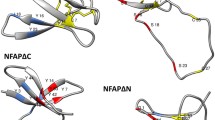Abstract
To determine the structural requirements of arenicin-1 in exerting antifungal activity, a truncated peptide with an N-terminal deletion and a peptide with an Ala substitution for an Arg in the beta-turn region were characterised by comparison to arenicin-1. The antifungal activities of the analogues were 25–50% lower than arenicin-1. Trp fluorescence and circular dichroism spectroscopy showed that Trp in the N-terminus contributed to peptide penetration and Arg in the beta-turn to conformational transition. These results suggest that Trp in the N-terminus and Arg in the beta-turn play a pivotal role in the membrane-directed antifungal activity of arenicin-1.


Similar content being viewed by others
References
Andrä J, Jakovkin I, Grötzinger J, Hecht O, Krasnosdembskaya AD, Goldmann T, Gutsmann T, Leippe M (2008) Structure and mode of action of the antimicrobial peptide arenicin. Biochem J 410:113–122
Hall K, Aguilar MI (2009) Membrane interactions of antimicrobial beta-peptides: the role of amphipathicity versus secondary structure induction. Biopolymers 92:554–564
Hwang JS, Lee J, Hwang B, Nam SH, Yun EY, Kim SR, Lee DG (2010) Isolation and characterization of Psacotheasin, a novel knottin-type antimicrobial peptide, from Psacothea hilaris. J Microbiol Biotechnol 20:708–711
Makovitzki A, Shai Y (2005) pH-dependent antifungal lipopeptides and their plausible mode of action. Biochemistry 44:9775–9784
Merrifield RB (1986) Solid phase synthesis. Science 232:341–347
Park C, Lee DG (2009) Fungicidal effect of antimicrobial peptide arenicin-1. Biochim Biophys Acta-Biomembr 1788:1790–1796
Persson S, Killian JA, Lindblom G (1998) Molecular ordering of interfacially localized tryptophan analogs in ester- and ether-lipid bilayers studied by 2H-NMR. Biophys J 75:1365–1371
Rao AG (1999) Conformation and antimicrobial activity of linear derivatives of tachyplesin lacking disulfide bonds. Arch Biochem Biophys 361:127–134
Rinaldi AC, Di Giulio A, Liberi M, Gualtieri G, Oratore A, Bozzi A, Schininà ME, Simmaco M (2001) Effects of temporins on molecular dynamics and membrane permeabilization in lipid vesicles. J Pept Res 58:213–220
Sheppard R (2003) The fluorenylmethoxycarbonyl group in solid phase synthesis. J Pept Sci 9:545–552
Tang M, Waring AJ, Hong M (2008) Arginine dynamics in a membrane-bound cationic beta-hairpin peptide from solid-state NMR. Chembiochem 16:1487–1492
Tang M, Waring AJ, Hong M (2009) Effects of arginine density on the membrane-bound structure of a cationic antimicrobial peptide from solid-state NMR. Biochim Biophys Acta-Biomembr 1788:514–521
Wright GD (2007) The antibiotic resistome: the nexus of chemical and genetic diversity. Nat Rev Microbiol 5:175–186
Yeaman MR, Yount NY (2003) Mechanisms of antimicrobial peptide action and resistance. Pharmacol Rev 55:27–55
Zhao H, Kinnunen PK (2002) Binding of the antimicrobial peptide temporin L to liposomes assessed by Trp fluorescence. J Biol Chem 277:25170–25177
Acknowledgment
This work was supported by the Marine and Extreme Genome Research Center Program of the Ministry of Land, Transportation and Maritime Affairs, Republic of Korea.
Author information
Authors and Affiliations
Corresponding author
Rights and permissions
About this article
Cite this article
Park, C., Cho, J., Lee, J. et al. Membranolytic antifungal activity of arenicin-1 requires the N-terminal tryptophan and the beta-turn arginine. Biotechnol Lett 33, 185–189 (2011). https://doi.org/10.1007/s10529-010-0402-x
Received:
Accepted:
Published:
Issue Date:
DOI: https://doi.org/10.1007/s10529-010-0402-x




